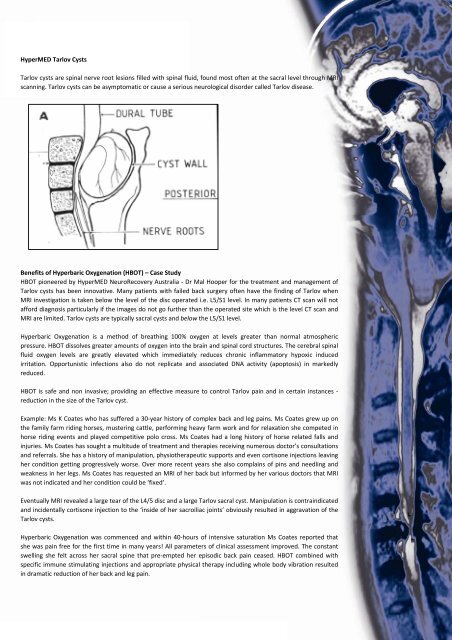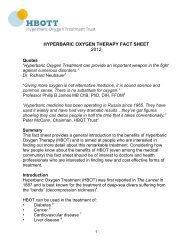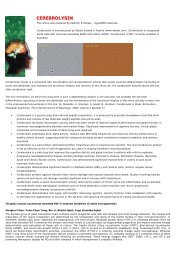You also want an ePaper? Increase the reach of your titles
YUMPU automatically turns print PDFs into web optimized ePapers that Google loves.
<strong>HyperMED</strong> <strong>Tarlov</strong> <strong>Cyst</strong>s<br />
<strong>Tarlov</strong> cysts are spinal nerve root lesions filled with spinal fluid, found most often at the sacral level through MRI<br />
scanning. <strong>Tarlov</strong> cysts can be asymptomatic or cause a serious neurological disorder called <strong>Tarlov</strong> disease.<br />
Benefits of Hyperbaric Oxygenation (HBOT) – Case Study<br />
HBOT pioneered by <strong>HyperMED</strong> NeuroRecovery Australia ‐ Dr Mal Hooper for the treatment and management of<br />
<strong>Tarlov</strong> cysts has been innovative. Many patients with failed back surgery often have the finding of <strong>Tarlov</strong> when<br />
MRI investigation is taken below the level of the disc operated i.e. L5/S1 level. In many patients CT scan will not<br />
afford diagnosis particularly if the images do not go further than the operated site which is the level CT scan and<br />
MRI are limited. <strong>Tarlov</strong> cysts are typically sacral cysts and below the L5/S1 level.<br />
Hyperbaric Oxygenation is a method of breathing 100% oxygen at levels greater than normal atmospheric<br />
pressure. HBOT dissolves greater amounts of oxygen into the brain and spinal cord structures. The cerebral spinal<br />
fluid oxygen levels are greatly elevated which immediately reduces chronic inflammatory hypoxic induced<br />
irritation. Opportunistic infections also do not replicate and associated DNA activity (apoptosis) in markedly<br />
reduced.<br />
HBOT is safe and non invasive; providing an effective measure to control <strong>Tarlov</strong> pain and in certain instances ‐<br />
reduction in the size of the <strong>Tarlov</strong> cyst.<br />
Example: Ms K Coates who has suffered a 30‐year history of complex back and leg pains. Ms Coates grew up on<br />
the family farm riding horses, mustering cattle, performing heavy farm work and for relaxation she competed in<br />
horse riding events and played competitive polo cross. Ms Coates had a long history of horse related falls and<br />
injuries. Ms Coates has sought a multitude of treatment and therapies receiving numerous doctor’s consultations<br />
and referrals. She has a history of manipulation, physiotherapeutic supports and even cortisone injections leaving<br />
her condition getting progressively worse. Over more recent years she also complains of pins and needling and<br />
weakness in her legs. Ms Coates has requested an MRI of her back but informed by her various doctors that MRI<br />
was not indicated and her condition could be ‘fixed’.<br />
Eventually MRI revealed a large tear of the L4/5 disc and a large <strong>Tarlov</strong> sacral cyst. Manipulation is contraindicated<br />
and incidentally cortisone injection to the ‘inside of her sacroiliac joints’ obviously resulted in aggravation of the<br />
<strong>Tarlov</strong> cysts.<br />
Hyperbaric Oxygenation was commenced and within 40‐hours of intensive saturation Ms Coates reported that<br />
she was pain free for the first time in many years! All parameters of clinical assessment improved. The constant<br />
swelling she felt across her sacral spine that pre‐empted her episodic back pain ceased. HBOT combined with<br />
specific immune stimulating injections and appropriate physical therapy including whole body vibration resulted<br />
in dramatic reduction of her back and leg pain.
Hyperbaric Oxygen Therapy Benefits<br />
• Mobilizes the patients own circulating stem cells providing a fertile neurovascular platform for further stem cell related therapies and<br />
implantation (American Journal Physiology ‐ Heart and Circulatory Physiology Nov 05)<br />
• Elevates the amount of dissolved Oxygen into compromised and damaged tissue structures. Accelerates recovery and promotes<br />
stabilization of individuals suffering complex and progressive neurodegenerative illness and disease<br />
• Enhances immune capabilities ‐ increasing white blood cell (WBC) and Natural Killer Cell (NK) function; accelerating wound healing and<br />
infection control. This has a ‘killing’ effect which dramatically raises the potential to fight chronic infection and overcome delayed healing<br />
• Accelerates new tissue formation (fibroblast and collagen synthesis) essential for repair – ligaments, disc, muscle and bone structures<br />
• Increases blood flow into retarded tissue by fostering new blood vessel capillary growth into the damaged and compromised areas. This<br />
is called neovascularization<br />
• Activates damaged and non‐functional neurons (nerve cells). This is extremely important in chronic injury including spinal cord, brain<br />
injury and neurologically impaired patients. Chronic swelling and inflammation deprives vital Oxygen, which results in nerve cells<br />
becoming abnormally low in metabolic function. In fact, in many spinal cord and brain injured patients’, nerve cells are not completely<br />
severed but remain intact. However, the nerve cells are ‘non‐functional’ because of the massive swelling that ultimately results in<br />
progressive scar formation because of Oxygen deprivation. Studies have demonstrated by raising the amount of Oxygen efficiency into<br />
the damaged area scar formation is reduced, blood flow is improved and dormant, non‐functional and damaged nerve cells can be<br />
reactivated. Obviously, the best outcome is to start with aggressive HBOT in the early stages of injury<br />
• Reinstates normal lymphatic drainage creating a ‘clearance’ effect reducing chronic swelling which causes painful inflammation<br />
• Many prescribed drugs, antibiotics and immune stimulating vitamins and amino acids require Oxygen and are in fact greatly enhanced<br />
with benefits of Hyperbaric tissue Oxygenation<br />
• HBOT changes cellular metabolism by altering Oxygen deprivation towards Oxygen efficiency at a cellular level; changing the cellular<br />
substrate from an anaerobic metabolism (energy poor) into an aerobic metabolism (energy rich). This has a net clearance effect enabling<br />
the body at a cellular level to detoxify and reverse the radical accumulation of toxins that ultimately mutate into abnormal cells<br />
(including cancer cells)<br />
• Significantly reduces the ability of chronic infections including bacterial, viral and cancer cells to replicate and proliferate. Chronic<br />
infections do not survive in a high Oxygenated environment<br />
Back ground<br />
<strong>Tarlov</strong> cysts are spinal nerve root lesions filled with spinal fluid. <strong>Tarlov</strong> cysts can be asymptomatic or cause a serious neurological disorder<br />
called <strong>Tarlov</strong> disease. A propensity for developing <strong>Tarlov</strong> cysts may be passed through the mother or father. A cyst will typically remain<br />
asymptomatic until the onset of the disease stage is initiated by an event such as an accident, heavy lifting, fall, or, hypothetically, another<br />
disease such as one of the many forms of Herpes, Chlamydia, Rickettsia, Mycoplasma and other opportunistic infections. Most often,<br />
however, the "trigger" is unknown.<br />
The onset of symptoms may be gradual or sudden, mild or severe. The progression and severity of symptoms differs widely. Typically, <strong>Tarlov</strong><br />
cysts in the disease stage cause symptoms in the distribution of the affected nerve root, initially pain, and, later, dysfunction. Without<br />
successful treatment, <strong>Tarlov</strong> disease may result in disability and require major lifestyle changes.<br />
<strong>Tarlov</strong> cysts differ in structure. A cyst might incorporate nerve elements or be free of them. A cyst can be valved or non‐valved. A valved cyst<br />
has a structure in its neck that makes it easier for cerebrospinal fluid (CSF) to enter the cyst than to leave it. In a non‐valved cyst, CSF flows<br />
freely between the cyst and the dural tube. Patients often describes ‘swelling that comes and goes’<br />
<strong>Tarlov</strong> cysts are typically on posterior roots; anterior cysts are rare. Multiple <strong>Tarlov</strong> cysts are not uncommon. Although a large cyst can cause<br />
symptoms by pressing on an adjacent structure, symptoms may also be caused by hydrostatic forces of the cerebrospinal fluid. The pulsating<br />
spinal fluid exerts pressure on nerves in the cyst or cyst wall, thus causing the cyst to expand, stretching nerve elements and causing or<br />
increasing symptoms. Therefore, cysts even smaller than one centimeter can be highly symptomatic. Manipulation in contraindicated.<br />
Common symptoms include sciatica and pain in the sacral area, and buttocks. The legs and feet may or may not be involved. Symptoms can<br />
be opposite‐sided. <strong>Tarlov</strong> cysts can also cause pain and disorders in the organs of elimination and reproduction, hypoesthesia, paresthesia,<br />
and pain in the thigh from lack of blood supply (neurogenic claudication). The postures of sitting, standing, walking, and bending are typically<br />
painful, and reclining flat on the side is usually the only posture that offers relief. Pain from <strong>Tarlov</strong> cysts is similar to pain from herniated<br />
lumbar discs and some gynecological disorders.
Are <strong>Tarlov</strong> cysts a kind of cancer?<br />
No. Symptomatic <strong>Tarlov</strong> cysts are morbid enlargements that continue to grow, which, according to some medical dictionaries, qualifies them<br />
to be classed as tumors. Although <strong>Tarlov</strong> cysts continue to grow, they do so, however, because of the pressure of spinal fluid within them,<br />
not through uncontrolled cell division as in the case of a neoplasm or cancer. Like cancer, <strong>Tarlov</strong> cysts can cause severe pain and damage<br />
distant organs such as the bladder and the brain by affecting the flow of cerebrospinal fluid and nerve energy. Therefore, although <strong>Tarlov</strong><br />
disease is not a form of cancer, and although its progression is typically slow, <strong>Tarlov</strong> disease should be taken with great seriousness.<br />
Can <strong>Tarlov</strong> disease cause death?<br />
<strong>Tarlov</strong> disease must be taken with great seriousness, because <strong>Tarlov</strong> disease can advance to the stage of constant severe pain. If not<br />
successfully treated, a person in this stage of the disease can die from the stress of the suffering, from the pain medications (hepatitis), or<br />
from suicide.<br />
What are the disability impacts of symptomatic <strong>Tarlov</strong> cysts?<br />
Different <strong>Tarlov</strong> cyst sufferers respond differently to various postures and activities, and there is no typical onset or rate of progression of the<br />
disease. Most have difficulty sitting, but a very few can sit all day. Some are relieved by standing or walking, though the great majority are<br />
made worse. Some experience severe pain at onset, but the symptoms are mild at onset in other cases.<br />
Many persons with <strong>Tarlov</strong> cysts report that they are able to exceed their usual postural or activity limits for a time, but they then "pay for it"<br />
by experiencing a delayed flare. For example, after exceeding their quota earlier in the day, they will later in the day experience pain that is<br />
so severe that, even with narcotic pain medication, they cannot sleep. Flares can last for days, weeks, and even months<br />
A doctor might write, correctly, "The patient showed no sign of distress during the visit," and the patient will be denied disability benefits<br />
because of that statement, even though, in fact, the patient was afterward housebound and bedridden for several days or weeks, because<br />
the amount of sitting and walking involved in the doctor's visit exceeded his or her personal quota.<br />
How to get a diagnosis?<br />
MRI investigation is provides accurate identification however MRI machines vary. Typical MRI is 1.5 Tesla however the advanced 3.0 Tesla<br />
Functional BOLD (Blood Oxygen Level Dependency) give more accurate information identifying sites of tissue hypoxia.<br />
What are the surgical options?<br />
Surgery is NOT recommended due to bladder and bowel complications.<br />
Do <strong>Tarlov</strong> cysts cause bladder problems?<br />
<strong>Tarlov</strong> disease often leads to retention, chronic subacute urinary tract infection (UTI) and other bladder problems, including interstitial<br />
cystitis, with or without felt symptoms. Symptoms might be falsely ascribed to age, gender (in the case of women), or other causes, rather<br />
than to the <strong>Tarlov</strong> cyst.







